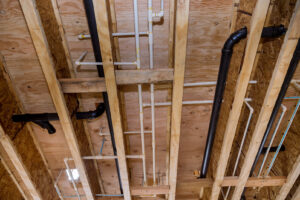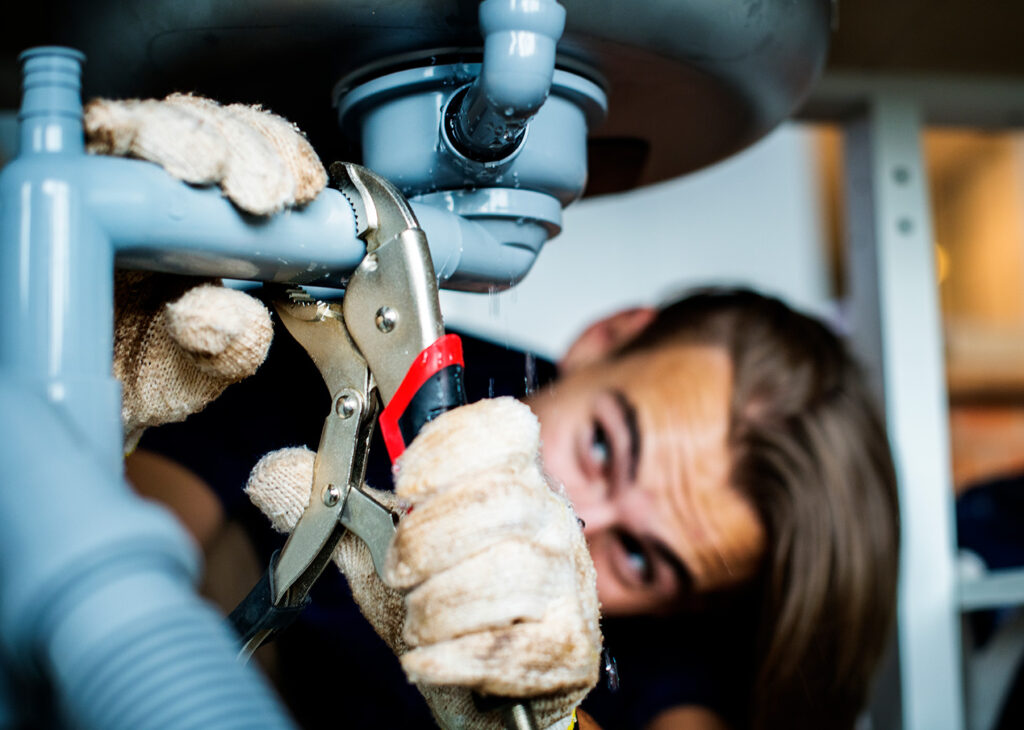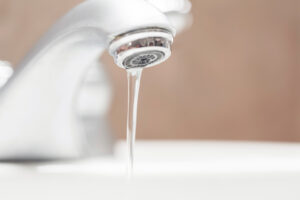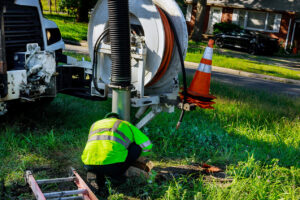When a burst pipe or hidden leak sends water gushing through your floors, every second counts in preventing extensive damage. This guide to emergency plumbing services shows homeowners and businesses exactly what to do before professional help arrives, covering immediate shut-off steps, water-damage mitigation, documentation for insurers, commercial building protocols, when to call Pither Plumbing’s 24/7 team, and long-term preparedness planning. You’ll learn how to locate valves, perform safe temporary fixes, protect assets, and streamline communication so that when our licensed technicians reach your door, they can deliver a fast, permanent repair.
What Are the First Steps to Take in a Plumbing Emergency?
Immediately addressing a plumbing emergency means cutting off water flow, powering down risky appliances, and diagnosing the issue to minimize flooding.
How Do You Locate and Shut Off the Main Water Valve?
Shutting off the main water valve stops the flow to every fixture and prevents escalating water damage.
- Identify the valve by tracing the largest pipe entering your property near the water meter or foundation.
- Turn the valve handle clockwise until it stops; for wheel-type valves, rotate fully.
- Confirm water is off by opening a faucet; lack of flow indicates success.
Closing this valve halts flooding and sets the stage for safe appliance shutdown.
Importance of Immediate Action in Plumbing Emergencies
Promptly addressing plumbing emergencies is crucial to minimize damage. Shutting off the main water valve and turning off water-related appliances are the first steps to take. These actions help prevent further water damage and potential hazards.
Federal Emergency Management Agency (FEMA), “FloodSmart”
This aligns with the article’s emphasis on the initial steps to take during a plumbing emergency.
How Can You Safely Turn Off Water-Related Appliances and Electricity?
Power and water create a hazardous combination when leaks occur, so cutting power to appliances protects both equipment and occupants.
- Switch off breakers for water heater, dishwasher, washing machine and any electric pumps.
- Locate gas shut-off for gas-fired water heaters if your property uses natural gas.
- Unplug portable appliances near the leak to prevent shock hazards.
With utilities secured, you can assess damage without risking electrical faults or fires.
How Do You Assess the Plumbing Problem Quickly?
A rapid diagnosis pinpoints whether you face a leak, burst pipe, or clog and guides your next actions.
- Inspect walls and ceilings for bulges or moisture stains indicating a hidden pipe break.
- Check under sinks, around joints, and at fittings for dripping or spraying water.
- Flush drains and toilets to see if water backs up, revealing clogs or blocked vents.
Accurate assessment helps you decide if a temporary fix is possible before professional arrival and leads to damage-control measures.
How Can You Minimize Water Damage While Waiting for the Plumber?
Containing water and protecting belongings reduces cleanup costs and structural harm until Pither Plumbing’s technicians can perform permanent repairs.
What Are Effective Ways to Contain Water and Protect Your Belongings?
When water pools, quick containment prevents soaked walls, warped floors, and ruined inventory.
Before tackling containment, gather buckets, towels, and a wet/dry vacuum if available.
- Place buckets under active drips and position towels around spreading water.
- Use plastic sheeting or tarps to shield furniture, electronics, and important documents.
- Employ a wet/dry vacuum to remove standing water from floors and low-lying areas.
These steps halt water migration and safeguard valuables until the leak source is secured.
What Temporary Fixes Can You Apply Safely Before Help Arrives?
A well-applied temporary fix can stem major leaks without exposing you to undue risk.
Before proceeding, ensure water is off at the main valve and power to nearby appliances is cut.
- Apply a pipe clamp or hose repair clamp over a small leak to compress the damaged section.
- Wrap waterproof tape or self-vulcanizing plumber’s tape tightly around a pinhole drip.
- Use epoxy putty on small cracks for a short-term seal—follow manufacturer’s cure times.
These measures offer a stopgap but require professional inspection and permanent repair once our team arrives.
How Should You Document Plumbing Damage for Insurance and Repair?
Clear visual and written records of damage and repair needs accelerate insurance claims and inform plumbers of on-site conditions.
Documenting Plumbing Damage for Insurance Claims
Documenting plumbing damage with photos and videos is essential for insurance claims. Clear visual records help insurers understand the extent of the damage and expedite the approval process. Detailed documentation streamlines communication with insurers and plumbing crews.
Insurance Information Institute, “How to File a Homeowners Insurance Claim”
This supports the article’s guidance on documenting damage for insurance purposes.
What Photos and Videos Should You Take to Support Your Claim?
High-quality imagery ensures insurers understand the extent of damage and accelerates approvals.
- Capture wide-angle shots showing affected rooms and water spread.
- Photograph close-ups of burst areas, dripping joints, and corrosion signs.
- Record videos illustrating active leaks, discoloration, and structural impacts.
Thorough visual evidence substantiates your claim and guides our technicians toward the correct tools and materials.
How Do You Organize Documentation for Efficient Communication?
Systematic documentation streamlines discussions with insurers and plumbing crews.
Action | Tool | Purpose |
Create digital folder | Smartphone or camera | Centralize all images and videos |
Name files chronologically | Filename convention | Ensure insurer and plumber see progression of damage |
Add brief captions | Notes app or spreadsheet | Explain location, date, and severity in each image |
Having organized records ready means you spend less time explaining details and more time getting professional repairs underway.
What Are the Specific Emergency Plumbing Steps for Commercial Properties?
Commercial buildings have complex water systems and high-value assets, so emergency steps must align with facility management protocols.
How Do You Locate and Shut Off the Main Water Valve in Commercial Buildings?
Commercial shut-off valves are often housed in utility rooms or mechanical closets under lock and key, requiring coordination with facility personnel.
- Consult building schematics or facility managers to pinpoint the valve’s location.
- Use access keys or lockboxes as authorized by management to reach the valve.
- Turn off the valve using wrench attachments provided for heavy-duty valves.
Coordinating with on-site staff minimizes downtime and prevents accidental activation by untrained occupants.
How Can Businesses Protect Operations and Assets During a Plumbing Emergency?
Minimizing business interruption requires quick action to shield equipment, inventory, and critical processes.
- Move sensitive electronics and documents above flood level or to dry storage.
- Back up digital systems and shut down nonessential machinery to prevent electrical damage.
- Cover manufacturing lines, retail inventory, and raw materials with waterproof tarps.
These precautions maintain operations where possible and reduce asset losses until full repair.
What Are Best Practices for Communicating with Employees and Occupants?
Clear, timely communication keeps people safe and informed during disruptive emergencies.
- Activate pre-defined safety protocols and share instructions via email, text, or PA system.
- Mark restricted zones around flooded areas with cones, tape, and signage.
- Provide evacuation or shelter-in-place directives if required by safety teams.
Maintaining transparent communication prevents confusion and ensures a controlled response while awaiting professional plumbing services.
When and Why Should You Call Professional Emergency Plumbing Services?
Knowing when to stop DIY efforts and contact a licensed plumber ensures permanent repairs, safety, and warranty compliance.
Why Is Professional Help Essential for Plumbing Emergencies?
Licensed plumbers deliver precision diagnostics, code-compliant repairs, and durable solutions beyond temporary fixes.
- They identify hidden damage behind walls or under slabs that DIY attempts often miss.
- Professional-grade tools and materials ensure a lasting repair rather than repeated leaks.
- Compliance with local codes and permits prevents costly violations and property devaluation.
Calling trained technicians at the right moment avoids further deterioration and potential safety hazards.
What Makes Pither Plumbing’s 24/7 Emergency Service Reliable?
Pither Plumbing has provided emergency plumbing services in Longview, TX, since 1952, with a commitment to prompt response and advanced techniques.
- Our 24/7 dispatch model guarantees a qualified technician on-site within hours of your call.
- We leverage state-of-the-art leak detection and repair technology to restore water integrity quickly.
- Decades of customer satisfaction and local accreditation reflect our trustworthiness and expertise.
Knowing that Pither Plumbing stands ready around the clock gives you peace of mind in any plumbing crisis.
How Can You Prepare Your Home or Business for Future Plumbing Emergencies?
Proactive maintenance and clear action plans reduce response time and damage when the next emergency strikes.
What Are the Key Plumbing Components to Know and Maintain?
Familiarity with critical components empowers swift action and early detection of issues.
- Main Water Valve: Test quarterly to confirm smooth operation and accessibility.
- Water Heater: Drain sediment annually and inspect for corrosion to prevent leaks.
- Pipes and Drains: Schedule routine inspections to clear clogs and identify wear.
Routine upkeep of these elements lowers the chance of sudden failures and guides faster emergency interventions.
How Can You Create an Emergency Plumbing Action Plan?
A written plan aligns household members or staff on rapid response roles, resources, and contacts.
- Map all shut-off valves and post locations visibly near entry points.
- Assemble an emergency kit with basic tools: wrench, pipe clamps, plumber’s tape, rags.
- List emergency contacts: local utility, Pither Plumbing’s 24/7 hotline, insurance agent.
- Train occupants or employees on valve operation and initial containment steps.
A clear, practiced plan ensures everyone knows their role, reducing panic and accelerating damage control when water intrudes.
What Are Common Questions About Emergency Plumbing Services?
Homeowners and facility managers frequently ask about immediate actions, leak control methods, and appliance safety in urgent plumbing scenarios.
What Is the First Thing to Do in a Plumbing Emergency?
Immediately locate and shut off the main water supply to stop flooding and protect your property from escalating water damage.
How Do You Stop a Burst Pipe from Flooding Your Property?
Shut off the main valve, contain water with buckets and towels, apply a temporary clamp or tape, then call a licensed plumber for a permanent solution.
Should You Turn Off Your Water Heater During a Leak?
Yes, cutting power or gas to your water heater prevents damage to the appliance and reduces the risk of electrical hazards or scalding when the main supply is off.
Taking swift, informed action before a professional arrives can save thousands in repair and restoration costs. By following these steps—shutting off water, containing leaks, documenting damage, and knowing when to call Pither Plumbing’s trusted 24/7 emergency team—you safeguard your home or business against catastrophic water damage. Prepare now, stay calm under pressure, and contact our Longview, TX experts instantly for reliable, permanent plumbing solutions.







